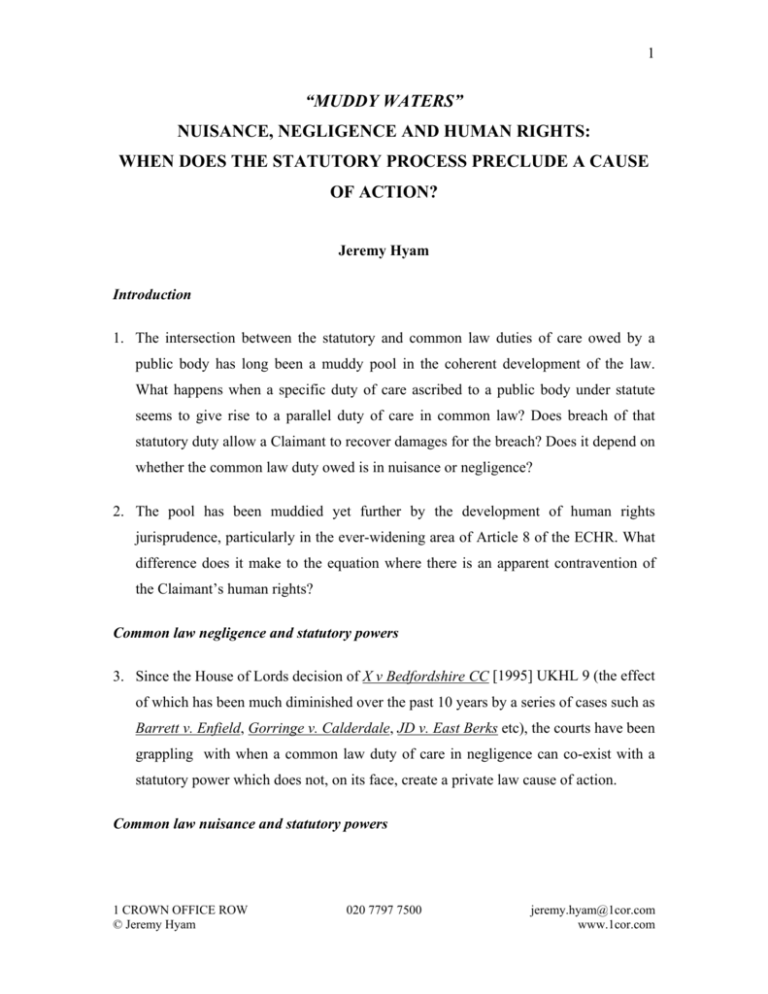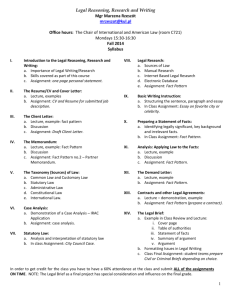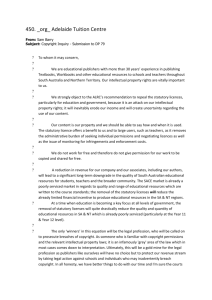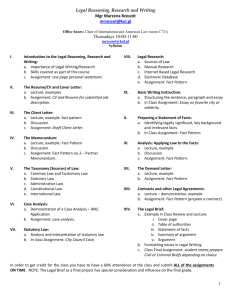View Handout - One Crown Office Row
advertisement

1 “MUDDY WATERS” NUISANCE, NEGLIGENCE AND HUMAN RIGHTS: WHEN DOES THE STATUTORY PROCESS PRECLUDE A CAUSE OF ACTION? Jeremy Hyam Introduction 1. The intersection between the statutory and common law duties of care owed by a public body has long been a muddy pool in the coherent development of the law. What happens when a specific duty of care ascribed to a public body under statute seems to give rise to a parallel duty of care in common law? Does breach of that statutory duty allow a Claimant to recover damages for the breach? Does it depend on whether the common law duty owed is in nuisance or negligence? 2. The pool has been muddied yet further by the development of human rights jurisprudence, particularly in the ever-widening area of Article 8 of the ECHR. What difference does it make to the equation where there is an apparent contravention of the Claimant’s human rights? Common law negligence and statutory powers 3. Since the House of Lords decision of X v Bedfordshire CC [1995] UKHL 9 (the effect of which has been much diminished over the past 10 years by a series of cases such as Barrett v. Enfield, Gorringe v. Calderdale, JD v. East Berks etc), the courts have been grappling with when a common law duty of care in negligence can co-exist with a statutory power which does not, on its face, create a private law cause of action. Common law nuisance and statutory powers 1 CROWN OFFICE ROW © Jeremy Hyam 020 7797 7500 jeremy.hyam@1cor.com www.1cor.com 2 4. In cases based on nuisance, environmental lawyers have been grappling with Marcic v Thames Water Utilities Ltd [2004] AC 42 which suggests that a duty to avoid Leakey nuisance, is inconsistent with the statutory scheme under s.94(1)(a) of the Water Industry Act.. 5. Leakey nuisance, or the Leakey principle, may be stated as follows:“the occupation of land carries with it a duty to one’s neighbour. An occupier must do whatever is reasonable in all the circumstances to prevent hazards on his land, however they may arise, from causing damage to his neighbour” Dobson: meeting of the principles 6. The case of Dobson, recently heard before the TCC (Ramsey J) is of interest because the two lines of authority intersect and shed new light on the extent to which common law duties can co-exist with statutory powers. It is this case which I am going to focus on in this talk. The full reference for the case Hanifa Dobson v Thames Water Utilities [2007] EWCH 2021 (TCC). The common law background for negligence claims: X v Bedfordshire et al. 7. Before I discuss the case of Dobson, I should outline the recent case-law in relation to the existence of common law duties in negligence in and around the exercise or discharge of statutory powers and functions. 8. The starting point for this discussion is the HL decision in X v Bedfordshire, where Lord Browne-Wilkinson said that a claimant could have a cause of action flowing from the careless exercise of statutory powers or duties, as long as he can show that the circumstances are such as to raise a common law duty of care. He was careful to draw a distinction between: 1 CROWN OFFICE ROW © Jeremy Hyam 020 7797 7500 jeremy.hyam@1cor.com www.1cor.com 3 a) the exercise of a statutory discretion, and b) implementing a statutory duty in practice. (An example of (a) would be a decision whether or not to exercise a statutory discretion to close a school; whereas an example of (b) would be the actual running of a school pursuant to the statutory duties.) 9. If the issue concerns the latter - the implementation of a statutory duty in practice – it was held that the common law duty to take reasonable care could arise. 10. If the issue concerns the exercise of a statutory discretion built in to the Act – the general rule was said to be that it is for the public authority, not for the courts, to exercise the discretion. Therefore the issue will not be actionable at common law. 11. The rationale for this distinction is that the local authority should not be liable in private law for damages for doing that which Parliament has authorised by statute. 12. However, if the decision complained of relates to a matter of statutory discretion but the decision in fact falls outside the statutory discretion (e.g. it is ultra vires), it can but not necessarily will - give rise to common law liability. Thus in Barret v. Enfield [2001] 2 AC at 572, Lords Slynn said:“A claim of negligence in the taking of a decision to exercise a statutory discretion is likely to be barred, unless it is wholly unreasonable so as not to be a real exercise of discretion, or if it involves the making of a policy decision involving the balancing of different public interests;” 13. However he continued:“acts done pursuant to the lawful exercise of the discretion can, however, in my view be subject to a duty of care, even if some element of discretion is involved.” 1 CROWN OFFICE ROW © Jeremy Hyam 020 7797 7500 jeremy.hyam@1cor.com www.1cor.com 4 14. The difficult question of when a cause of action in negligence can exist in conjunction with a statutory power - if that statutory power does not expressly create a private law cause of action - was further illuminated by Lord Steyn in his speech in Gorringe v. Calderdale Metropolitan Borough Council [2004] 1 WLR 1057 at 1059. After review of the line of cases from X v. Bedfordshire, Stovin v. Wise; Phelps v. Hillingdon LBC he said:“There are two comments on these decisions I would make. First, except on a very careful study of these decisions, there is a principled distinction which is not always in the forefront of discussions. It is this: in a case founded on breach of statutory duty the central question is whether from the provisions and structure of the statute an intention can be gathered to create a private law remedy? In contradistinction in a case framed in negligence, against the background of a statutory duty or power, a basic question is whether statute excludes a private law remedy. An assimilation of the two inquiries will sometimes produce the wrong results.” 15. Lord Hoffman in the same case said this at [38]: “In such cases the fact that the public authority acted pursuant to a statutory power or public duty does not necessarily negative the existence of a duty. A hospital trust provides medical treatment pursuant to the public law duty in the 1977 Act, but the existence of its common law duty is based simply upon its acceptance of a professional relationship with the patient no different from that which would be accepted by a doctor in private practice. The duty rests upon a solid, orthodox common law foundation and the question is not whether it is created by the statute but whether the terms of the statute (for example in requiring a particular thing to be done or conferring a discretion) are sufficient to exclude it. The law in this respect has been well established since Geddis v. Proprietors of Bann Reservoir (1878) 3 App Cas 430.” 16. Finally, and again from the same case, is Lord Scott who at [71] said: “In my opinion, if a statutory duty does not give rise to a private right to sue for breach, the duty cannot create a duty of care that would not have been owed at common law if the statute were not there. If the policy of the statute is not consistent with the creation of a statutory liability to pay compensation for damage caused by a breach of the statutory duty, the same policy would, in my opinion, exclude the use of the statutory 1 CROWN OFFICE ROW © Jeremy Hyam 020 7797 7500 jeremy.hyam@1cor.com www.1cor.com 5 duty in order to create a common law duty of care that would be broken by a failure to perform the statutory duty” Common law nuisance and Marcic 17. Many if not all of you will be familiar with case of Marcic. In a nutshell, Mr Marcic, a homeowner, brought a claim against Thames Water hoping to be awarded damages in respect of the repeated flooding of his property with sewage which was caused by the overloading of the nearby sewers. 18. The claim was brought on the twin bases of common law nuisance and with human rights (namely Article 8 – the right to respect for private and family life, and article 1 of the First Protocol – the right to peaceful enjoyment of possessions). Both of these breaches, in respect of Mr. Marcic’s case, mirrored a specific statutory duty owed by Thames Water under s.94(1)(a) of the Water Industry Act 1991 to members of the public: namely to ‘improve and extend its sewerage system, so as to ensure that the local area is effectively drained’ (and thus, by necessary implication, guarding against the flooding of sewage). 19. The House of Lords found against the Claimant in Marcic. One key aspect of their decision was that the means of enforceability for the statutory duty in question was specifically prescribed elsewhere in the relevant Act. Specifically, s.94(3) of the Water Industry Act directs any person affected by a breach of that duty to seek an enforcement notice against the undertaker from the Director of Water Services at Ofwat, using the procedure set out under s.18. 20. Lord Nicholls referred to the case of Robinson v Workington Corporation [1897] 1 QB 619: a 19th Century authority with similar facts to Marcic. It was obviously decided pre- the Water Industry Act, but the Public Health Act 1875 contained a similar duty and a mechanism for enforcement (which was then to seek a ‘writ of 1 CROWN OFFICE ROW © Jeremy Hyam 020 7797 7500 jeremy.hyam@1cor.com www.1cor.com 6 mandamus’ from the Local Government Board as the equivalent of a notice of enforcement.) He quoted Lord Esher MR who said (p.61): ‘It has been laid down for many years that, if a duty is imposed by statute which but for the statute would not exist, and a remedy for default or breach is provided by the statute that creates the duty, that is the only remedy’. 21. With respect to the Marcic case: not only does s.18 of the Act set out a procedure for obtaining an enforcement order, but it goes on further to ring-fence this procedure by explicitly limiting the availability of other remedies available. s.18(8) states: ‘Where any act or omission constitutes a contravention of…a statutory or other requirement enforceable under this section, the only remedies for that contravention, apart from those available by virtue of that section, shall be those for which express provision is made by or under any enactment and those that are available in respect of that act or omission otherwise than by virtue of its constituting such a contravention.’ 22. The Lords took the view that the nature of the Defendant, and the existence and contents of the relevant statute in Marcic, distinguished it from the Leakey line of cases (Leakey v National Trust [1980] QB 485), and thus exempted it from the principle of nuisance liability upheld in those cases: namely that where an occupier of land has knowledge of a hazard to another landowner posed by the accumulation of a substance on its land, it has a duty to take such steps as are reasonable in all the circumstances to discharge it. As Lord Nicholls put it: ‘Thames Water is no ordinary occupier of land’ and its ‘obligations regarding these sewers cannot sensibly be considered without regard to the...statutory scheme’. 23. The second issue considered by the Lords in Marcic, was the viability of the human rights claim. The respective judgements of Lord Nicholls, Lord Hoffmann and Hope (Lords Steyn and Scott concurring) stated that the reasoning was similar to that used in respect of the common law claim: that precedence should be given to the 1 CROWN OFFICE ROW © Jeremy Hyam 020 7797 7500 jeremy.hyam@1cor.com www.1cor.com 7 prescribed statutory scheme for enforcement, as long as that scheme strikes an appropriate balance between the needs of the individual and the community. As Lord Hope put it, in relation to the scheme set out in s.18 of the Water Industry Act: ‘Parliament has decided that the most appropriate method of achieving a fair balance between the competing interests of the individual and the community is by means of a statutory scheme administered by an independent expert regulator, whose decisions are subject to JR if there is a doubt as to whether the necessary balance has been struck in the right place’. (Para 77) 24. Lord Hope noted that ‘the European Court has repeatedly recognised the value to be attached to the process of review by a judicial body that has full jurisdiction’ (para 83). He also pointed to ECHR authorities such as Hatton v UK which accord the Convention a subsidiary role in respect of the implementation of social and economic policies by state legislatures, giving them a ‘wide margin of appreciation’ (para 84). [Hatton v UK: Application No 36022/97, 8 July 2003 ( a case concerning a complaint made under article 8 about aircraft noise from night flights at Heathrow). 25. In assessing the adequacy of the statutory scheme, the Lords looked at the particular route to enforcement set out in s.18 and the nature of the obligation on the Director to make an enforcement order in similar cases. They commented on the balancing act that needs to be undertaken by the Director of Ofwat between the interests of individual homes at risk of flooding, and interests of the company’s customers who have to pay for the cost of works to alleviate that risk. 26. They looked at the issues pertaining to enforcement in the particular case brought by Mr Marcic, in particular the significant financial implications of requiring Thames Water were to carry out remedial work (essentially, to build new sewers). They took into account a report by the Director of Ofwat estimated the cost at £50-70,000 per property, amounting to a total of £1 billion, without taking into account future house building. 1 CROWN OFFICE ROW © Jeremy Hyam 020 7797 7500 jeremy.hyam@1cor.com www.1cor.com 8 Dobson 27. It is against the background of these two lines of authority on nuisance, negligence and statutory powers that we now have the decision of Ramsey J in Dobson. 28. This was a trial of 14 preliminary issues based on assumed facts. The claim was brought as a group action by a large number of residents of Isleworth and Twickenham who live near the Mogden Sewage Treatment Works, run by Thames Water. Their complaint was/is that odours and mosquitoes from the Sewage Works have caused them a nuisance, and their case is that the cause of that nuisance was Thames Water’s negligence in failing to treat the sewage properly. In addition to nuisance and negligence, they sought damages under the Human Rights Act for breach of their rights under Article 8 and article 1 of the First Protocol. 29. One element of Thames Water’s defence was that the complaints of nuisance and negligence in the case amounted to a complaint that it had breached its duties under s.94(1)(b) of the Water Industry Act 1991, in ‘failing effectually to deal with the contents of the sewer’. A cause of action (whether in nuisance or negligence) to seek a remedy in respect of such a breach was therefore precluded by the decision in Marcic. 30. The Claimants contended that they were not, in fact, seeking to enforce those statutory duties – for the following reasons: a) The obligation under s.94(1)(b) is only concerned with “effectually dealing with the contents of the sewers” and that this does not extend to environmental protection issues. b) A duty to “maintain or cleanse” does not exist under the s.94(1)(b) and cannot be implied, and as such s.94(1)(a) is distinct from s.91(4)(b); 1 CROWN OFFICE ROW © Jeremy Hyam 020 7797 7500 jeremy.hyam@1cor.com www.1cor.com 9 c) Effectually dealing with the contents does not extent to treatment of the contents; it relates to the task of getting rid of the contents, or administering them, and claimed that this interpretation is supported by British Waterways Board v Severn Trent Water. d) Moreover, the Claimants sought to distinguish the case from Marcic on the basis that capital expenditure was not required to deal with the problem in the same way; Marcic was essentially a case to determine whether or not Thames Water should be required by a court to increase their capacity by building more or better sewers; whereas this case was about the need for sewage works to be cleaned and maintained so that they have “better environmental controls”, and this falls outside of Marcic. e) The Claimants contended in the alternative that, even if they were seeking to enforce s.94(1)(b) duties, then the effect would be to allow Thames Water to cause a nuisance, which could not have been parliament’s intention. They referred to a DEFRA Code of Practice on Odour Nuisance from Sewage Treatment Works, which sets out the practice to be followed by local authority environmental health officers in respect of statutory nuisance proceedings under s.80 of the Environment Protection Act, and pointed out that Ofwat did not seek to argue about that enforcement regime in their response to DEFRA’s consultation on the Code. 31. Thames Water denied all of those contentions. a) As for the contention that ‘effectually dealing with’ sewage did not include treatment of the sewage, they asserted that it did, and in so doing relied on the provision of the Urban Waste Water Treatment Regulations (1994) which implemented an EC Directive by 1 CROWN OFFICE ROW © Jeremy Hyam 020 7797 7500 jeremy.hyam@1cor.com www.1cor.com 10 amending s.94 WIA, naming ‘treatment’ of sewage as being within the duty imposed by subsection (1)(b). b) They did not accept that s.94(1)(a) and (b) were distinct provisions for the purposes of enforcement of the statutory scheme, but contended that they were in fact closely related. c) They concurred with the Claimants that the effect of s.94(1)(b) was to give them the statutory right to commit a nuisance without contention, and argued that there is nothing objectionable about that as it was simply the effect of Marcic. d) They rejected the Claimant’s argument that the claim could be distinguished from Marcic on the basis that it did not require them to dedicate more resources to address the problems at the Mogen Sewage Works. Capital expenditure would be required to deal with the problem, and this was the realm of Ofwat. 32. Ofwat supported Thames Water’s submissions in respect of the question of whether the Claimants were seeking to enforce a statutory duty and added that there was nothing in the DEFRA Code could not affect the proper construction of s.94(1)(b). 33. Ramsey J’s findings on the key issues in the case were as follows: (a) That the Claimants were seeking to enforce duties which arise under section 94(1)(b) of the Water Industry Act in respect of odours from Mogden STW and/or Mosquitoes which live and breed as a result of sewage or sewage sludge at Mogden STW and/or the plant or equipment holding or treating such sewage or sludge. (b) The Claimants were precluded from bringing a claim in nuisance, absent any negligence by reason of the principle in Marcic. 1 CROWN OFFICE ROW © Jeremy Hyam 020 7797 7500 jeremy.hyam@1cor.com www.1cor.com 11 (c) The Claimants were precluded by the principle in Marcic from bringing claims for nuisance involving allegations of negligence or based on negligence under the HRA where the exercise of adjudicating on that cause of action is inconsistent and conflicts with the statutory process under the WIA. (d) The extent to which the claims in negligence were “inconsistent and in conflict with” the statutory process under WIA was “a matter of fact and degree” not suitable for disposal as a preliminary issue. Having said that, causes of action based on the physical operation and/or operational management of the works are not likely to be precluded but that will depend on the facts. (e) Damages for nuisance might confer a sufficient remedy on those with a legal right to occupy such as to disentitle those living in the same household without such a legal right to a separate remedy under Article 8 and/or the HRA. When the court awards damages for nuisance to those with a proprietary interest those damages will usually afford just satisfaction to partners and children but that there might be circumstances where they will not. Comment 30. There are three matters which are noteworthy about these conclusions. 31. First, Ramsey J. has fashioned a entirely pragmatic outcome to the preliminary issues which permits the Claimants claims to continue to the extent that (i) they are based on negligence or human rights involving negligence and not nuisance and (ii) they are based on operational as opposed to policy matters, but in deference to the fact that there is no bright line between policy and operational matters, he has concluded that it is a matter of “fact and degree” only suitable for determination after hearing the full facts. 1 CROWN OFFICE ROW © Jeremy Hyam 020 7797 7500 jeremy.hyam@1cor.com www.1cor.com 12 32. Second, despite his conclusion above, it is clear that he felt that those matters which were essentially operational would give rise to a cause of action. 33. Third, he upheld the Defendants arguments that there could be no separate claims for children under the HRA, at least on the one case he had pleaded before him, which involved the child of parents who were making a nuisance claim. The parents’ award for nuisance would be just satisfaction for any alleged infringement of the child’s rights. He did not though exclude the fact that there may be circumstances which give rise to such separate claims, and although he did not give examples, the sort of examples raised by the Claimants were foster children, and lodgers. This matter remains to be determined at the substantive hearing. The primary issue: a duty of care co-existing with a statutory duty 34. From the above authorities it should be reasonably clear that the reason why such claims as were being brought by the Claimants should co-exist with the statutory duty under WIA s.94(1))(b) is because the statutory framework does not exclude, nor is it inconsistent with the existence of a private law cause of action for breach of duty at common law. This follows from the line of authorities that runs from X v Beds. to Gorringe v. Calderdale. 35. The superficially surprising conclusion that, having accepted that the Claimants were attempting to enforce duties under the statutory scheme viz. the effectual cleaning of sewers, he should nonetheless held that: a) there co-existed a common law duty in respect of the discharge of that statutory duty; and b) that the extent to which such co-existent common law duty survived the decision of Marcic, was the policy/operational distinction about which (as he recognised at [141]) Lord Browne-Wilkinson’s had expressed clear reservations in Barrett v. Enfield [2001] 2 AC 557; 1 CROWN OFFICE ROW © Jeremy Hyam 020 7797 7500 jeremy.hyam@1cor.com www.1cor.com 13 is explained by the fact that Marcic is properly only dealing with nuisance under the Leakey principle, the existence of which cause of action was held to be inconsistent with the statutory scheme. Not so claims in negligence in respect of the discharge of the statutory duty to effectually clean the sewers. 36. The decision is perhaps best explained by drawing the important distinction recognised by Lord Steyn in Gorringe: “whether from the provisions and structure of the statute an intention can be gathered to create a private law remedy? In contradistinction in a case framed in negligence, against the background of a statutory duty or power, a basic question is whether statute excludes a private law remedy. 37. Marcic was a case which more conveniently falls into the former category, or at least is a case where the duty in nuisance is inconsistent with the statutory scheme and it cannot have been envisaged that the statute intended to create a private law right to compensation for such nuisance. 38. By contrast, Dobson falls into the latter category. This was a case where negligence was framed against the background of a statutory power. The relevant question for Ramsey J. was essentially whether the statute excluded a private law remedy or was inconsistent with it. His answer, that it did not, was (it is respectfully suggested) correct. 39. As to the scope of the duty, should it have been limited to operational matters? Again (it is respectfully suggested) the judge was right. The distinction may however better be described not as the policy operational distinction (see e.g. Dorset Yacht) but rather the distinction recognised in Rowling v. Takaro Properties Ltd [1988] AC 473, 501G where the Privy Council held that: “It is only where the decision involves the weighing of competing public interests or is dictated by considerations which the courts are not fitted to assess that the courts will hold that the issue is non-justiciable on the ground that the decision was made in the exercise of a statutory discretion.” 1 CROWN OFFICE ROW © Jeremy Hyam 020 7797 7500 jeremy.hyam@1cor.com www.1cor.com 14 40. The close analysis of what Marcic did and did not decide is helpful. Notably, the observation of Lord Nicholls, Lord Hoffman and Lord Hope, that s.18(8) of the WIA did not rule out the existence of “other remedies” except insofar that a cause of action for Leakey nuisance was inconsistent with the duty under s.94(1)(a). 41. As a result the muddy waters created by the different strands of common law authority on negligence and nuisance co-existing with statutory powers, are now perhaps a little clearer. 1 CROWN OFFICE ROW © Jeremy Hyam 020 7797 7500 jeremy.hyam@1cor.com www.1cor.com







